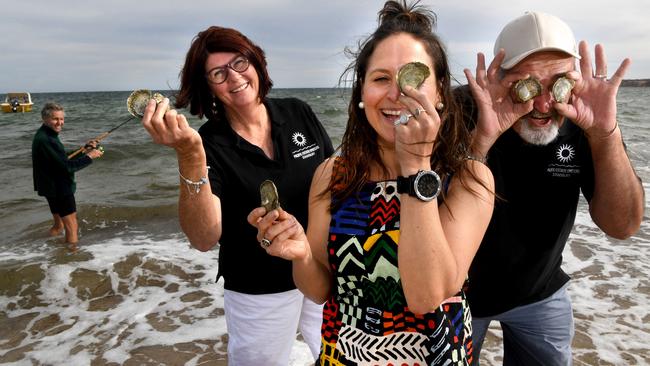All eyes on the return of baby native oysters for Windara Reef in the Yorke Peninsula
One of SA’s most popular holiday and fishing spots is eagerly awaiting the beginning of the end of a 183-year-old environmental disaster with the arrival soon of millions of baby native oysters.

SA News
Don't miss out on the headlines from SA News. Followed categories will be added to My News.
One of South Australia’s most popular holiday and fishing spots is eagerly awaiting the beginning of the end of a 183-year-old environmental disaster with the arrival soon of millions of baby native oysters.
The oysters will be added to the largest man-made oyster reef in the southern hemisphere, off Yorke Peninsula, in the coming months.
The tiny molluscs, measuring 2mm in diameter, will be hand-placed by Whyalla divers over a week across 144 separate limestone blocks strategically placed to create the Windara Reef in the Gulf of St Vincent.
The baby oysters will provide the critical foundational glue needed for marine life to grow, thrive and attract more fish to the reef, decimated from 1836 by settlers.
The Windara Reef is located 8m underwater at low tide just off the coast of Rogue’s Point, 7km south of Ardrossan.

But it will take 20 years for the reef to reach its original state, says the Nature Conservancy’s marine restoration co-ordinator Anita Nedosyko.
Ms Nedosyko says Windara Reef will restore a threatened ecosystem, improve water quality and, most importantly, return fish and attract more tourists to the area.
“Every hectare of naturally restored reef attracts the equivalent of five tonnes of extra fish each year,” she says.
“So, yes, the reef is about bringing this ecosystem back from the brink of extinction but it’s also about creating more experiences for recreational fishers, swimmers, snorkellers and divers, who, in turn, will sustain the local economy.”
Keen recreational fisher and Balaklava GP Dr Daryl Burford says: “I’m really hoping it will bring in some whiting and garfish.
“But I don’t want too many people to know about it.”
He’s been holidaying at his family’s Rogue’s Point shack since he was a child, recalling hours spent reeling in buckets of local fish.
Dr Burford says fish stocks have significantly declined since then.
“If we do nothing about it we are in real trouble, which is very sad because we want our children to enjoy what we did as kids but at the moment all they’re likely catch is a few tommies in one day.”
Stansbury oyster farmers Steve and Gerri Bowley say it’s pretty simple science with significant benefits.
“It’s a win-win,” says Mr Bowley, who will supply 50,000 baby Australian native oysters to the reef.
The oysters were donated by the South Australian Research and Development Institute and the Bowleys have been raising them for transfer to the reef.
“We know the value of local oyster farms to the natural ecosystem — we see it every day in what we do — we see fish teeming around the oysters,” says Mr Bowley.
The project is the result of a collaboration between the SA Government, the Nature Conservancy, the Federal Government, Yorke Peninsula Council and the University of Adelaide.


